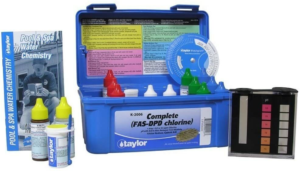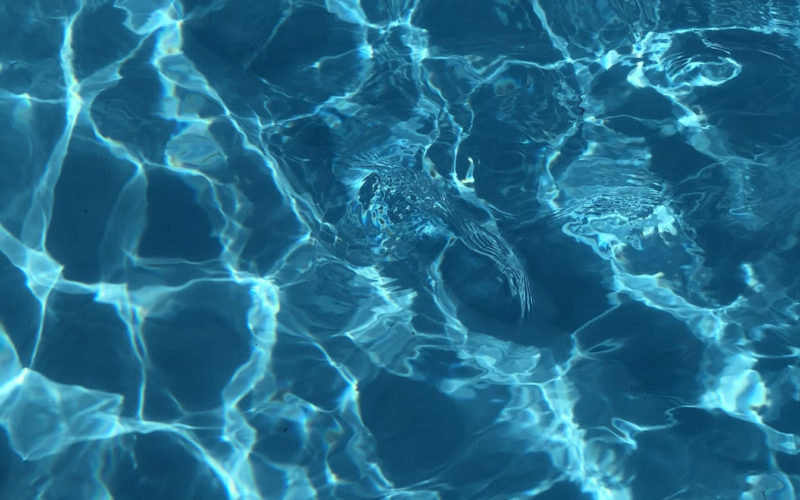We all want our pool to be perfect, with crystal clear and safe water. But then, you encounter confusing terms like free chlorine vs. total chlorine, and it feels like a headache. These words can make pool care seem tricky, and if you get it wrong, it can cause a lot of problems. But take a deep breath — we’ve gathered all the info you need to make it easy to understand and manage.
Balancing free and total chlorine is simpler than it may seem. The key lies in having reliable and accurate test kits and test strips, which are crucial for a safe and enjoyable pool experience. Get ready to dive into the difference between free chlorine and total chlorine, where we’ll make pool chemistry simple, so you can enjoy your sparkling water without the hustle.
 AquaChek Pool and Spa Test Strips Winner category: Easiest to use and read | Features Includes 7 tests: Total Chlorine, Free Chlorine, Bromine, pH, Alkalinity, Total Hardness, Cyanuric Acid Jump to the detailed reviews |
 Taylor Technologies Test Kit Winner category: Most accurate results | Features Includes 7 tests: Total Chlorine, Free and Combined Chlorine, Bromine, pH, Alkalinity, Total Hardness, Cyanuric Acid Jump to the detailed reviews |
Free Chlorine vs. Total Chlorine: What’s the Difference?

When it comes to keeping pool water clean and safe, understanding the difference between free chlorine and total chlorine is fundamental. These two indicators play an important role in maintaining pool sanitation. But there is a third type — combined chlorine.
Let’s learn what each of these terms means and why they are important.
- What is free chlorine?
Imagine free chlorine as the diligent guardian of your pool. When you add chlorine to the pool, it reacts with the water to form one of two compounds: and . They are on the front lines, actively combating any potential threats like the growth of bacteria, algae, and other contaminants. This type of chlorine is your primary line of defense; it works tirelessly to sanitize the water and keep it safe for swimming.
- What is combined chlorine?
Imagine chlorine that has fought contaminants, has done its duty, and is now retired. In other words, combined chlorine is no longer actively engaged in sanitizing your pool. Instead, it has already bonded with organic matter in your pool water, such as bacteria, sweat, or algae. When you detect that familiar chlorine odor around the pool, you’re sensing combined chlorine.
- What is total chlorine?
Total chlorine, as the name implies, includes all forms of chlorine in your pool water. It is the sum of free and combined chlorine. Measuring total chlorine provides a complete picture of the general chlorine concentration in your pool.
Which One Is More Important?
Now that we know the definition of each type of chlorine, you may be wondering: which one is more important for my pool? The answer is that all three components are critical to maintaining a clean pool and working as a team.
To keep your pool water crystal clear and safe, you need to balance these three chlorine elements effectively. So, in the world of pool care, it’s not about a battle of free chlorine vs. total chlorine. It’s about understanding their roles and working together to create the perfect swimming experience.
What Is Better for Measuring Chlorine Levels: Test Strips or Test Kits?

Chlorine testing typically comes in two main forms: total chlorine tests and free chlorine tests. Combined chlorine tests are not common because you can easily find its level by subtracting the free chlorine level from the total chlorine level. The ideal option is usually a product that can test both types at once. Test kits and test strips are the most widely used tools for this purpose, and each has its unique set of advantages and disadvantages.
Test strips are a quick and convenient way to check the level of chlorine in the water. Budget-friendly and easy to use, they have become a popular choice among many pool owners. It is enough to dip the strip into the pool water, wait a while, and compare the color of the strip with a reference chart on the container. Unfortunately, they do not always give accurate results, which can lead to problems with the pool.
On the other hand, test kits are famous for their super accurate results. They can give you a complete picture of what’s going on with your pool chemistry. But such high accuracy comes at the price of more complicated and time-consuming use. Additionally, test kits tend to come with a higher price tag. Despite all the disadvantages, test kits remain the favorite choice of experienced pool owners.
Best Testing Products: Detailed Reviews
AquaChek Pool and Spa Test Strips — The Easiest To Use and Read
Winner category: The easiest to use and read
Pros
- The most user-friendly — everyone can master water testing with these strips without any problems
- Fastest to show results — dip, wait 15 seconds, and your result is ready
- Highest quality of all test strips; chemicals on the strip do not mix after dipping
- The most convenient for regular testing, as one pack will last for a whole year
- More budget-friendly than test kits
Cons
- Test strips do not give as accurate results as test kits
AquaChek Pool and Spa Test Strips are very popular among pool owners because they’re super easy to use. Even if you’re new to pool care, you can easily master them. These strips are great for checking your pool’s chlorine levels regularly. Just dip one in the pool water, wait for 15 seconds, and then match the color to the chart on the container.
The best part is that these strips cover all the important tests in one go, giving you a complete picture of your pool’s chemistry in a single look. Keep in mind, though, that while they’re good for routine checks, they may not be as accurate as test kits.
So, if you want an easy and quick way to keep an eye on your pool’s chlorine levels without much hassle or added costs, these strips are a solid choice.
Taylor Technologies Test Kit — The Most Accurate Results
Winner category: The most accurate results
Pros
- The most accurate among all test kits, which is especially valuable when you need to diagnose a problem
- The best tool for testing chlorine levels. Including a test, this kit can detect not just free and total chlorine but also combined chlorine levels
- Has the most sturdy container designed for extended durability
- Gives a complete picture of water chemistry as it includes 7 tests
- Has very detailed and easy-to-follow instructions
Cons
- Requires careful following of instructions and is not as easy to use as test strips
- Can be tricky for beginners, but there are lots of great videos on YouTube with explanations
The Taylor Technologies Test Kit is known for its accuracy and is a top choice among experienced pool owners. It’s especially helpful when you need to figure out and solve specific pool water problems because it gives you detailed information about not just the three types of chlorine but all other important factors. Another standout feature is its sturdy container. It’s built to last and has enough space to keep all the chemicals neatly organized.
However, it’s important to know that this kit might be a bit more complicated to use compared to test strips. You’ll need to follow the instructions carefully. But if you want the most accurate and detailed information about your pool water, the Taylor Technologies test kit is a solid investment.
Finding the Right Balance Between Free Chlorine and Total Chlorine

Maintaining your pool’s chemical balances is like managing a complex mechanism where all parts work together. This may sound complicated, but a smooth-running mechanism that is regularly monitored is quite easy to maintain. Getting the right balance between free chlorine, combined chlorine, and total chlorine is super important to keep your pool safe and looking great. So, let’s break it down into simple steps:
- Regularly (minimum twice a week) measure the free chlorine and total chlorine levels in your water to be aware of and manage deviations from the safe level in time.
- Free chlorine levels should be in the ideal range of 2-4 ppm or the safe range of 1-6 ppm to effectively protect your pool.
- The difference between total chlorine and free chlorine will tell you the level of combined chlorine.
- Normally, the total chlorine level is equal to or slightly higher than the free chlorine level. This means that your pool is free of contaminants.
- If the level of combined chlorine is over 1 ppm, then there are a lot of contaminants in your water that the chlorine has reacted with, and you need to increase the free chlorine level.
- The pH level actively affects the effectiveness of free chlorine (the higher it is, the less effective free chlorine is), so we recommend keeping it between 7.2 and 7.8.
Imbalance in Total and Free Chlorine and How to Fix It
Of course, it would be wonderful to have a perfectly balanced pool at all times, but unfortunately, it is not always up to us. Many external factors can destroy your hard work, and in this case, it is important to identify the source of the problem and find the best solution. To help you navigate these situations, we’ve put together a handy guide describing common imbalances and how to correct them:
| Free and total chlorine is high | – Adding too much chlorine to the pool – Decreased chlorine demand due to fewer swimmers or lower temperature | – Allow chlorine levels to drop naturally (sunlight and aeration) – Add fresh water to the pool to dilute it – Use a chlorine neutralizer |
| Free and total chlorine is low | – Low chlorine level – Wasting of chlorine due to intensive pool use or sunlight exposure | – Add more chlorine to your pool – Treat your pool with shock to increase the chlorine level |
| Free chlorine is low and total chlorine is high | – Accumulation of combined chlorine due to contaminants such as sweat, bacteria, or algae – Not enough free chlorine to control contaminants – Free chlorine is bound by too much stabilizer | – Treat your pool with shock to remove combined chlorine – Provide proper pool cleaning to minimize contaminants – Add fresh water to the pool to dilute it if a high level of stabilizer is the problem |
| Free chlorine is high and total chlorine is low | Inaccurate testing or chemical dosing | – Retest the pool water with a test kit and revise the dosage – Monitor chlorine levels every day and correct dosage as needed |
Summary
Complex terms and pool chemistry can make caring for your pool a challenge. We realize that the topic of free chlorine vs. total chlorine may seem like a mystery at first. But here’s the good news: we’ve solved that mystery for you.
Pool chemistry doesn’t have to be complicated. We’ve compiled everything you need to understand chlorine balancing in this guide. How to achieve success? Regular testing and the right tools, such as reliable test kits and test strips, are your main weapons. With them, pool maintenance will go from a headache to an easy walk.
FAQ
🤔 Is free chlorine more important than total chlorine?
Knowing the levels of both free chlorine and total chlorine is important to keep your pool balanced, so we can’t say that one is more important than the other.
😱 Why does my pool have total chlorine but no free chlorine?
High levels of total chlorine and low levels of free chlorine can indicate a high level of contaminants in the water. In our article, you can read how to solve this problem.
⚡ Does shock treatment increase free chlorine?
Yes, shock treatment increases the free chlorine in the pool. Adding chlorine shock significantly increases the free chlorine level, while non-chlorine shock releases the combined chlorine, so it becomes free chlorine.
🏊 Is a high free chlorine level good for my pool?
A too high free chlorine level in a pool can negatively affect water quality, swimmers’ health, and equipment. The appropriate free chlorine level for a pool depends on the type of pool (residential or commercial), its use, water temperature, and local regulations. But on average, the ideal range is 2-4 ppm, while a safe range is 1-6 ppm.
👩🔬 What is the difference between free chlorine and total chlorine tests?
The main difference between free chlorine and total chlorine tests is that a free chlorine test measures the concentration of active, available chlorine in water, while a total chlorine test measures the combined concentration of both free chlorine and combined chlorine.






